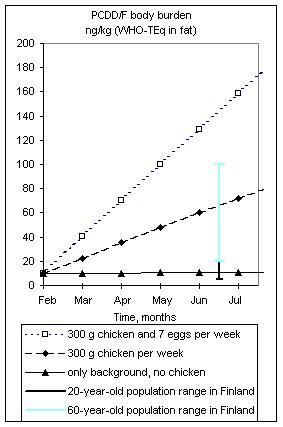Belgian chicken incident
This page is a encyclopedia article.
The page identifier is Op_en3449 |
|---|
| Moderator:Henrik (see all) |
|
|
| Upload data
|
Belgian chicken incident, a food contamination incident in Belgium. In January 1999 a large tank of recirculated fats was contaminated probably by PCB oil. Refined fat was sold to more than ten animal feed factories (the contaminated lot probably only to two factories, both in Belgium), which again sold their contaminated feed to farms, mostly chicken farms. The problem was noticed when the chickens showed symptoms of toxicity: low fertility and deformed chicks. The contamination of chicken feed is essentially a PCB problem, not a primary dioxin problem. The amount of PCB oil, causing the measured concentrations in the animal feed need not be more than about 10 litres. This could be the content of one or a few transformers. The highest concentrations of PCBs found in chicken fat have been 51 mg/kg (Σ7PCB in fat) (51,000 ng/g) (see seven marker PCBs), and the highest dioxin concentration 0.0026 mg/kg (2,613 ng/kg, as I-TEq or TCDD-equivalents in fat). PCBs have later (in summer 1999) been found also in pork, but not in milk at concentrations above the general background. In chicken or chicken feed samples there were 50,000 times more PCBs (Σ7PCB) than dioxin-TEqs, and the ratio is fairly constant. This means that monitoring in this specific case can be based on PCBs. As a screening analysis this can be performed in many laboratories, whereas dioxin analysis is extremely difficult and there are very few laboratories in Europe capable of performing them reliably. Also the cost of dioxin analysis is prohibitively expensive (of the order of 1000 euro per sample) and the analysis is time-consuming (about 1 month). Therefore routine monitoring cannot be based on dioxin analyses or congener-specific PCB analysis using mass spectrometry.
Figure 1. Modelled increase in the body burden of a person who consumes continuosly the worst-contaminated chicken from Belgian chicken incident. A, six-month follow-up; B, 70-year follow-up. Assumptions: half-life: 8.6 years, body fat content: 15 kg, PCDD/F concentration in chicken: 1000 ng/kg (TEq in fat), chicken fat content: 15 % (per wet weight).

